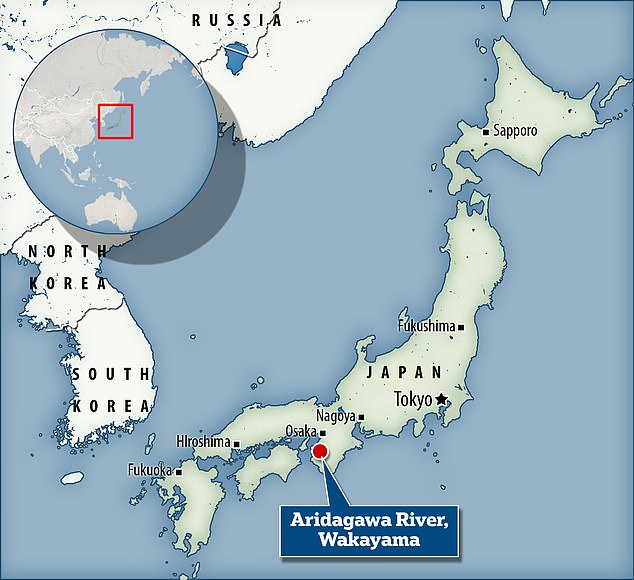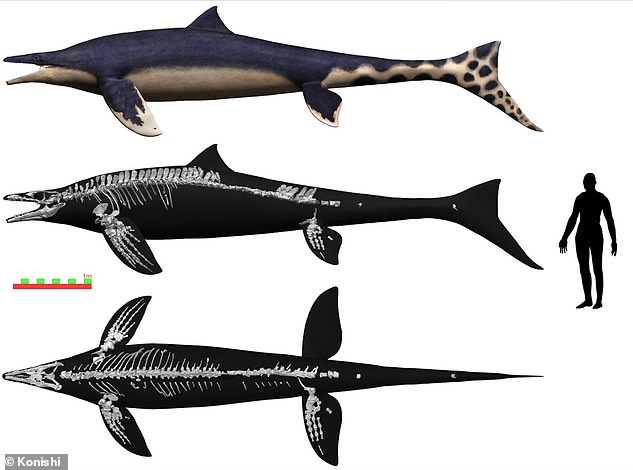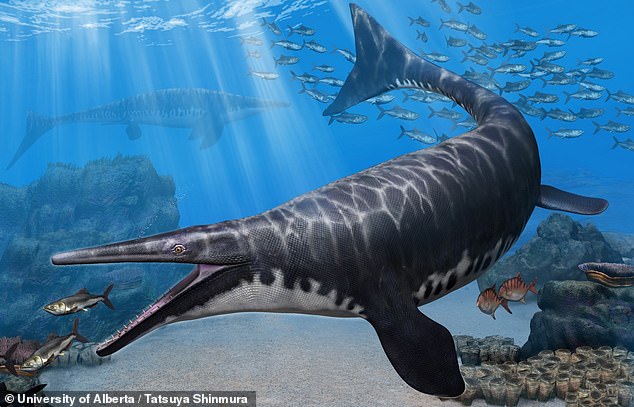Real-life Godzilla? Giant Japanese ‘blue dragon’ terrorised Pacific seas 72 million years ago – and scientists say they’ve never seen anything like it
It is one of the most famous monsters in science fiction.
And now scientists have discovered the real Godzilla: a huge water lizard that dominated the Pacific seas 72 million years ago.
The Wakayama Soryu, meaning Blue Dragon, was the size of a Great White Shark and used its four enormous flippers to move quickly through the water.
And while it may not be as big as the radioactive Godzilla, this newly discovered creature is completely unique.
Professor Takuya Konishi of the University of Cincinnati, who classified the specimen, said: 'It was immediately something I had never seen before.'
The Wakayama Soryu was about the same size as a modern Great White Shark and is said to have been one of the largest aquatic predators of its time

Scientists have discovered a giant prehistoric 'dragon lizard' near the Aridagawa River, Wakayama Prefecture, Japan
The enormous mosasaur was discovered around the Aridagawa River in Wakayama Prefecture, Japan.
The skeleton was accidentally discovered in 2016 by co-author Akihiro Misaki during a search for ammonite fossils.
Misaki came across a dark bone in the sandstone that turned out to be a vertebra from the most complete specimen of a mosasaur ever discovered in Japan or the northwest Pacific Ocean.
It then took four years to carefully remove the skeleton from the sandstone in which it was stuck.

Scientists say the Wakayama Soryu might have terrorized the waters off the coast of what is now Japan about 72 million years ago

While it may not be as large as Godzilla (depicted in a scene from “Godzilla, King of the Monsters!”), the Wakayama Soryu would still have been at the top of the prehistoric food chain.
Professor Konishi says he named the sea monster after the prefecture where it was discovered and after the dragons from Japanese mythology.
'In China, dragons thunder and live in the sky. In Japanese mythology they became aquatic,” he said.
The research article published in the Journal of Systematic Paleontology classifies this as a type of mosasaur – a giant prehistoric lizard.
Mosasaurs are not dinosaurs and are actually more closely related to modern lizards and snakes.
They were the apex predators of the prehistoric oceans from about 100 million to 66 million years ago.
They mostly hunted smaller fish, although some fossils have shown that they also ate other members of their own species.
Fossil remains of Mosasaurs have now been found all over the world, from Antarctica to the Sahara.
They existed around the same time as Tyrannosaurus Rex, and at 36 feet (11 meters) long, the largest specimens ever discovered were almost as big.
Mosasaurs were also wiped out when an asteroid struck what is now the Gulf of Mexico, leading to the mass extinction of the dinosaurs.

Features of the fossil's vertebrae suggested that the Blue Dragon had a dorsal fin, making it completely unique among Mosasaurs
However, the classification of the Blue Dragon is not that simple.
Unique among mosasaurs, the Japanese specimen's hind fins are larger than the front pair and even longer than the head.
There is also evidence that it had a dorsal fin, like that of a shark or dolphin, something otherwise never seen in mosasuars.
Professor Konishi found that the neural spines along the vertebrae of the fossil were very similar to those of a porpoise.
The scientists claim that the apparent differences in the neural spines of part of the spine match those found in modern-day dolphins and toothed whales.
The researchers think the Blue Dragon would have used its large front fins to maneuver quickly, while, like an airplane, the rear fins provide space for diving or rising to the surface.

Other mosasaurs such as Gavialimimus almaghribensis (pictured) had no dorsal fin and had a pair of hind fins that were smaller than the front pair
Meanwhile, like other mososaurs, the creature used its enormous tail to provide the rapid acceleration that made it a deadly predator.
Professor Konishi said: 'We lack a modern analogue that has this kind of body morphology – from fish to penguins to sea turtles – none have four large webbed feet that they use in combination with a tail fin.'
Some other prehistoric marine animals, such as the mosasaur, also used large paddle fins, but none did so as well as a large tail.
“It opens a whole can of worms that challenges our understanding of how mosasaurs swim,” says Professor Konishi.
'The question is how all five of these hydrodynamic surfaces were used. Which ones were intended to be sent? Which one for propulsion?'

